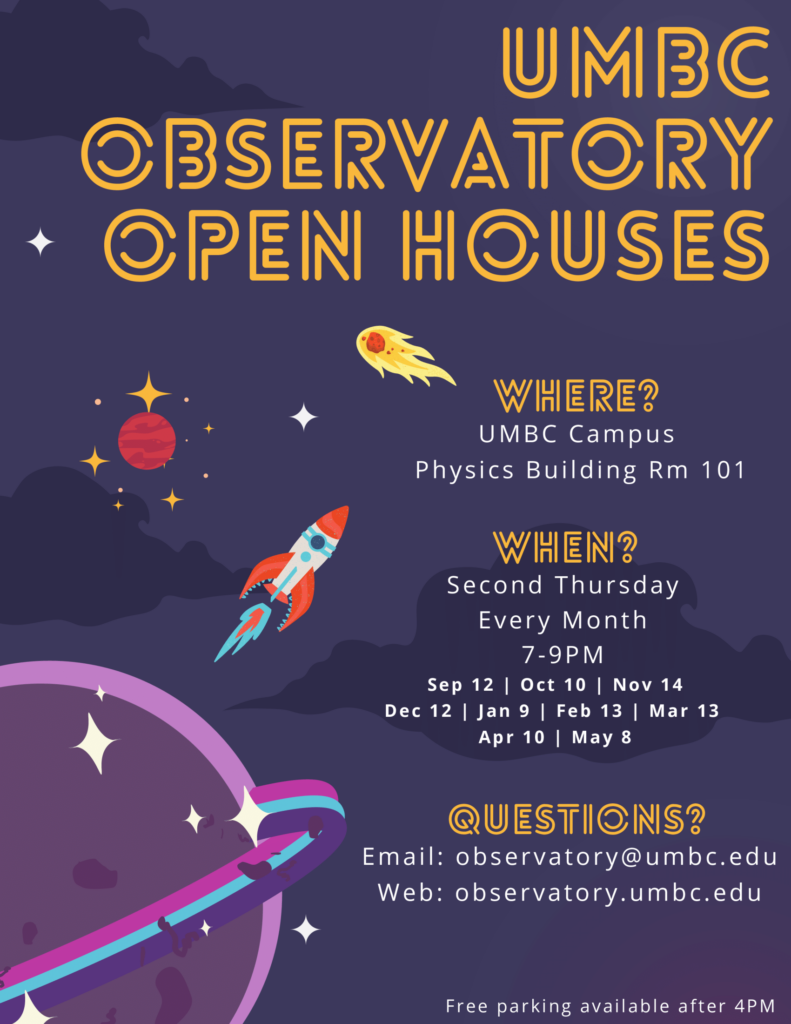Overview
The FY25 Open House Program at the UMBC Observatory will consist of monthly scheduled Open House events throughout the academic year. These events aim to engage the broader UMBC community, both on- and off-campus, as well as individuals affiliated and non-affiliated with UMBC. The program will be executed by Observatory Student Staff, under the supervision of the Outreach Coordinator, Jade Dorsainvil.
An up-to-date listing of all upcoming events is located under the “News & Events” tab.
 See the bottom of this page for a listing of downloadable flyers.
See the bottom of this page for a listing of downloadable flyers.
What happens?
Open House events are primarily a talk led by the observatory’s staff, after which, audience members may choose to tour the facility. If atmospheric conditions are appropriate, small telescopes may be set up outside for viewing bright objects in the sky. Less common is actually using the observatory’s telescope to perform observations.
Informal Talk (30-45 minutes)
These informal talks are developed and vetted by the UMBC Observatory Group to be geared toward ages 12 and above. As such, they focus on images and broad ideas concerning the topic at hand. Depending on the interests of the audience, the presenter may choose to delve more deeply into the detailed math or physics of a topic (but not for very long!). The talk is held in room 101 in the Physics Building on UMBC Campus. The room comfortably seats 50-75 people.
By “informal” we mean that this is not a class-style lecture. Please interrupt. Please ask questions. There will be no homework… but maybe a quick quiz here and there. Feel free to ask lots of questions or offer up your own understanding of what is being discussed. This way, we can all develop a better and deeper understanding of the topics being addressed.
Facility Tour (Optional; 10-15 minutes)
After the talk, guests may choose to tour our control room and the observatory’s dome. If you choose go to the control room, you will hear a brief explanation of how the telescope works as well as images obtained by the telescope of astronomical objects. Telescope targets typically include planets within the solar system, globular clusters, nearby nebulae, and more distant galaxies. Finally, if you choose to go all the way up into the dome, you can see the actual instrument. Please note the following regarding the observatory dome.
- The instrument is completely digital. You will not be able to look through any eye pieces on the main telescope. By request, or as it comes up in a lecture or audience question, smaller telescopes may be brought out and displayed in the main lecture hall.
- Access to the dome involves climbing and descending two ladders, which may be a challenge to some visitors such as young children or people with physical disabilities. Please refer to the Dome Access page to avoid disappointment.
Groups with interest in the observatory may also arrange visits if they wish to learn more about the astronomy conducted at the UMBC Observatory.
Flyers
Author: Various
Editor: Percy, Elammen, Roy
Date: 20240827